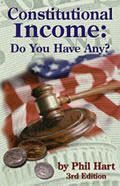Other
Ryter
Articles:
The Two Kerry's:
War Hero or
Traitor?
"Men in Black" The Cult of The Judges
GOVERNMENT
BETRAYS THE INDIANS AGAIN
By Jon Christian Ryter
September 18, 2005
NewsWithViews.com
In the 9-year legal battle over missing Blackfoot Indian royalties, US District Court Judge Royce Lamberth has been a perennial thorn in the side to the Justice and Interior Departments of both Bill Clinton and George W. Bush. The case, filed in Lamberth's court in 1996 is being fought over $137 billion in missing oil, timber, and grazing royalties and other lease payments due, not to the tribes but individually, to the Native American members of what is generically referred to as the Six Nations (now viewed as a composite of all of the known Indian tribes) on over 54 million acres of land.
When Lamberth�a colorful and very popular Washington, DC US District Court judge�determined in a July ruling that the failure of the Interior Department over several decades to accurately account for billions of dollars owed to the Indian tribes in the American Northwest was the epitome of incompetence by apathetic bureaucrats whose job it was to accurately tally the money owed to the Six Nations and to make timely and honest royalty payments to those who owned the land and were legally entitled to the proceeds from the royalties.
The lawsuit was originally filed in 1996 by a Blackfoot tribal leader, Elouise Cobell, as Cobell v Babbitt when her action was initially filed against the Clinton Interior Department and its Secretary, Bruce Babbitt. Cobell, 59, a Blackfoot banker from Montana filed the class action lawsuit based on the terms of the Dawes Act of 1887. Under the Dawes Act, the federal government initiated the practice of giving land allocations to the individual Indians as their reservations were reassumed by the government.
Each reservation-dweller Native American family was given a tract. The balance of the former reservations were either retained by the government or sold to land developers, mining companies, or oil drillers and refiners after vast reservoirs of natural resources were discovered beneath the northern plains early in this century.
Today, one Administration and a decade later, the 1996 lawsuit has been amended as Cobell v Norton. Even under the "compassionate" president, George W. Bush, the US government is not any closer to reaching a settlement. Unfortunately, the "accounting" of Indian wealth on-and-under the land given to the people of the Six Nations by "Karanduawn," the "Great White Father in Washington" has gotten worse. The government, according to Deputy Interior Secretary J. Steven Griles, is clueless how much�if any money�is owed to the Blackfoot and other Indian tribes. "Nobody has shown me that there is a loss," Griles said. "They haven't provided one shred of evidence [that the government owes them anything]."
Griles insists there is no evidence that the government owes the 50,000 member Blackfoot tribe�or any other tribe�money. He insisted it is incumbent upon the plaintiffs to prove the allegations that they've been cheated by the federal government. Several independent investigations have found enough evidence to convince Lamberth the action filed by Cobell has merit. Cobell's lawsuit was certified as a class action.
Even though the government initially insisted that its Indian Trust records were up-to-date and in good shape, a review ordered by Lamberth supported Cobell's contention that the Interior Department never kept complete records of lease payments by the oil companies, loggers, and agri-giants that leased vast tracts of farmland. In addition, Lamberth's investigation revealed that unknown amounts of Indian Trust money was simply deposited in the general treasury to help balance the federal budget. And, Lamberth learned, both the Clinton and Bush Administrations let oil and gas companies exploit Indian lands at bargain basement rates for what could be nothing other than quid pro quos.
Judge Lamberth described the case as the "...gold standard for mismanagement by the federal government for more than a century." In 1999 Lamberth ruled that the government had breached its fiduciary responsibilities to the trust. In the last hearing, in August, 2005, Lamberth chastised the federal government when he said: "On numerous occasions over the last nine years the Court has wanted to simply wash its hands of Interior and its iniquities once and for all. But doing so," he concluded, "would constitute an announcement that negligence and incompetence in government are beyond judicial remedy." In point of fact, Lamberth's worst fears have become fact. Our Constitution, and the liberty we have historically construed as God-breathed and inherent, is now construed by the government to be conditional�and based not on the Constitution of the United States but the UN Declaration of Human Rights whose privileges of liberty are retractable gratuities.
Lamberth ruled in July that the Interior Department's failure over several decades to account for billions of dollars due to Native Americans by the Bureau of Indian Affairs constituted "...outright evil, apathy, cowardice or crushing bureaucratic incompetence..." Lamberth told one Interior Department witness: "You know any banker would be in jail for handling funds like this, don't you?" The government lawyers, who feared the stinging wrath of the judge, cringed and decided that Lamberth had to go if they were ever going to prevail.
On August 15 the Justice Department filed a brief with the US Circuit Court of Appeals for the District of Columbia requesting that Lamberth be removed because he not only used intemperate language towards the government's lawyers, he ignored appellate rulings and accused the government of "...falsification, spite and obstinate litigiousness [with] no legal or factual basis." There was nothing wrong or improper in Lamberth's accusations towards the government's lawyers�particularly since Lamberth was correct. The Justice Department knew that not only was the US government was about to lose the biggest lawsuit in American history, the bureaucrats at the Department of Indian Affairs were going to be branded as thieves of the worst sort�stealing not from the richest, but the poorest, of all Americans.
The appellate court is actually considering the government's request. Clearly, if the Circuit Court of Appeals grants the government's wish, it will erase Cobell's chances of winning her lawsuit since the Justice Department will hand-pick a federal magistrate who will be much more sympathetic to the government's position.
Cobell has devoted most of her life to this issue. She travels between Washington and her home near Glacier National Park in Montana 40 weeks a year. Cobell admits she is not absolutely certain of the total amount owed to Native Americans, but only because she isn't certain precisely how much land the 300 to 500 thousand plaintiffs in her action actually own.
The Bush Administration�like the Clinton Administration before it�tried unsuccessfully to remove Lamberth from the case, hoping another judge would dismiss the lawsuit. Sen. John McCain [R-AZ] who chairs the Senate Indian Affairs Committee decided the only way this case will ever be resolved is to legislate a solution. In the spring of 2004 McCain asked Cobell what reforms in the Bureau of Indian Affairs she felt were needed, and what realistic amount would have to be offered for Cobell to settle the lawsuit. Cobell responded with 50 items that needed to be included in McCain's legislation to solve the problems in the Bureau of Indian Affairs, In addition, she said the Six Nations would settle for a cash payment of $27.5 billion�that was exempted from any taxes. The amount, she argued, was far less than the government actually owed the Indian Nations.
Cobell told McCain that Congress would have to appropriate new funds (not money from the Indian Tribe funds) to settle the claim since she knew if the "source" of the payment was not specified in the legislation, the government would simply shift funds from some other Indian relief program. Cobell also asked that a new Deputy Secretary of the Interior be appointed�a Native American�who would have complete oversight of the agencies that manage the Indian Trust.
McCain balked at all of her recommendations. The $27.5 billion, he said, was "...just way out of sight," adding that Congress would not appropriate "new money" to settle an old debt. The legislation, he said, would be the place where negotiations began. McCain introduced a bill which he called "...a starting point," knowing if the bill was passed and signed into law, it would become the final resting place of the Indian Trust claims. The bill does not mention any dollar amount that was construed to be "owed" to the Six Nations.
The plaintiffs in Cobell v Norton reacted angrily when they realized that the Chairman of the Indian Affairs Committee was not interested in resolving the lawsuit, only ending it. Cobell, in an interview with the Rapid City, SD Journal compared the McCain bill to the infamous Baker Massacre (considered to be the worst slaughter of unarmed American Indians by US troops). The comparison to the Baker Massacre brought the famous McCain temper to a boil as he defended his legislation in an Indian Affairs Committee meeting where he said the bill "...reflects extensive listening to the parties in the litigation, and it cannot credibly be compared to a massacre even in a figure of speech." McCain then advised the plaintiffs in Cobell v Norton to grab the chance to sit down with lawmakers and negotiate. "Leave the rhetoric to others," he advised Cobell. "You won't have this opportunity again anytime soon." (My observations of "government in action" is that anytime American citizens are willing to surrender their rights, government always has an outstretched hand.)
McCain's legislation would provide for a lump sum payment of whatever amount was deemed by the "appropriate authority" to be owed to the plaintiffs through a settlement fund administered by the US Treasury. One basic remains unanswered. How much money has the US government earned from leasing Indian land? No one knows. But it is likely in the hundreds of billions over the last 118 years.
|
Subscribe to the NewsWithViews Daily News Alerts! |
Ultimately what happened was the appointment of two mediators� approved by both sides�to attempt to iron out differences and arrive at a compromise that will work for both parties.
I guess it can honestly be said that the most heavily taxes Americans are Native Americans.
� 2005 Jon C. Ryter - All Rights
Reserved
Order Jon Ryter's book "Whatever Happened to America?"
Sign Up For Free E-Mail Alerts
E-Mails
are used strictly for NWVs alerts, not for sale
Jon Christian Ryter is the pseudonym of a former newspaper reporter with the Parkersburg, WV Sentinel. He authored a syndicated newspaper column, Answers From The Bible, from the mid-1970s until 1985. Answers From The Bible was read weekly in many suburban markets in the United States.
Today, Jon is an advertising executive with the Washington Times. His website, www.jonchristianryter.com has helped him establish a network of mid-to senior-level Washington insiders who now provide him with a steady stream of material for use both in his books and in the investigative reports that are found on his website.
E-Mail: BAFFauthor@aol.com
Unfortunately, the "accounting" of Indian wealth on-and-under the land
given to the people of the Six Nations by "Karanduawn," the "Great White
Father in Washington" has gotten worse.













